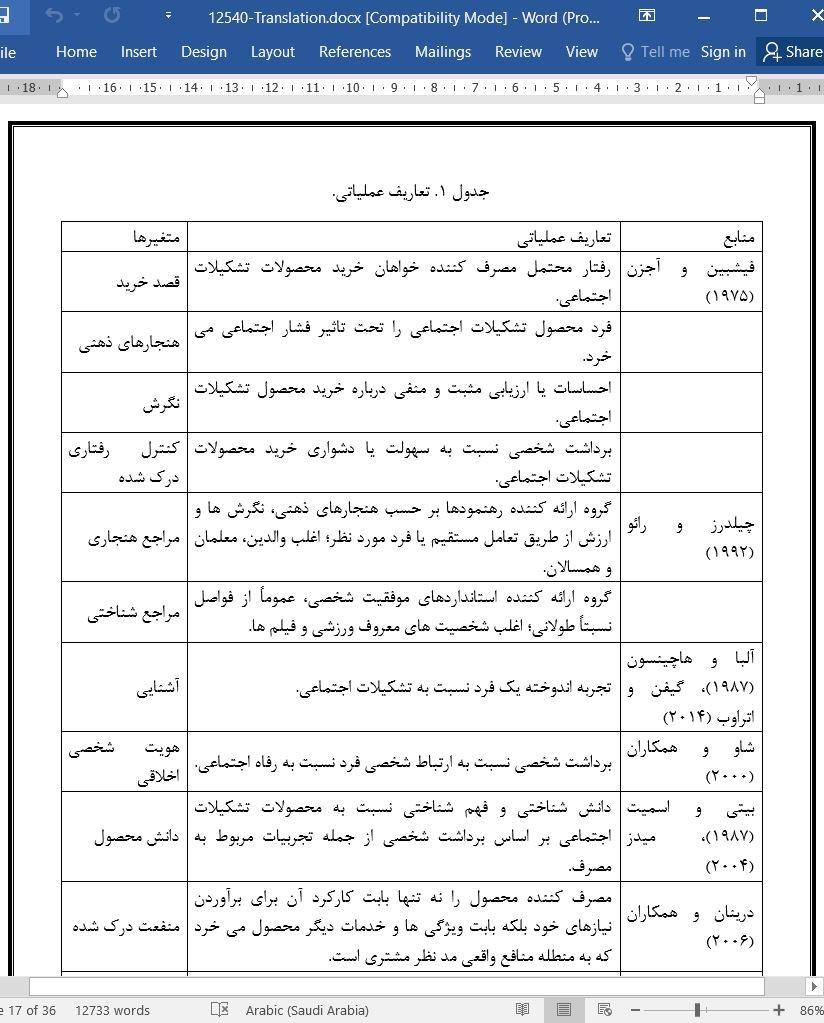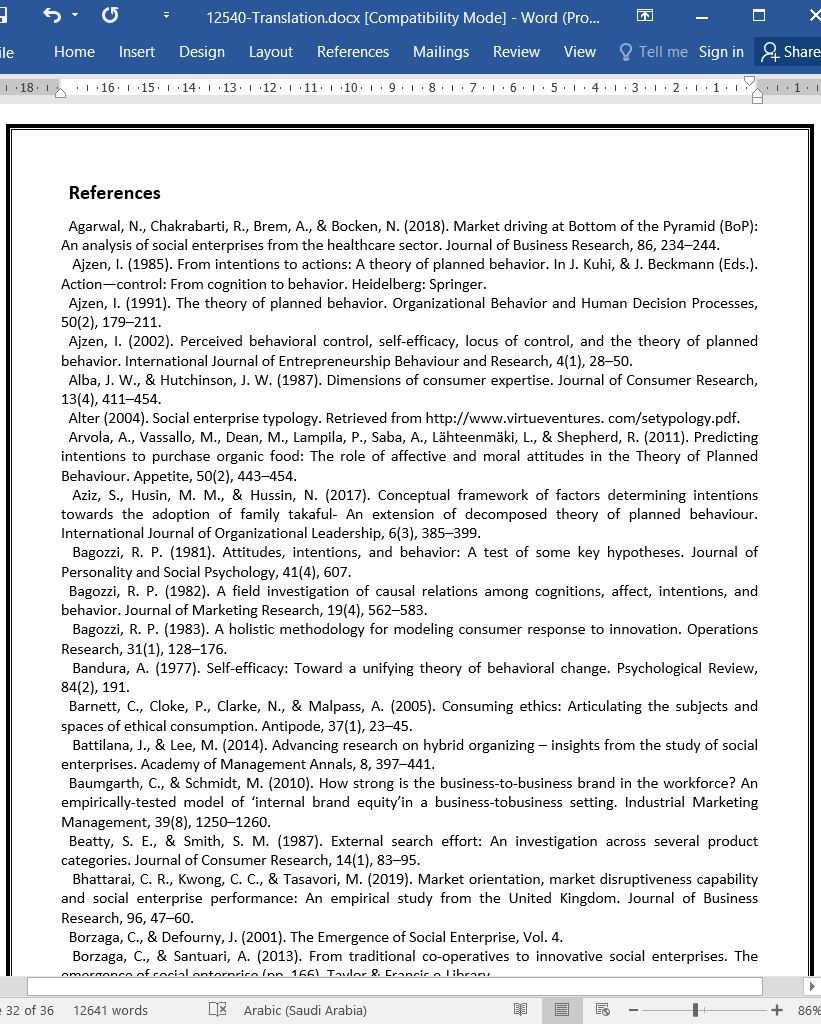
دانلود مقاله اثرات مقطعی رفتارهای مصرف کننده تشکیلات اجتماعی
چکیده
نوآوری اجتماعی و تشکیلات اجتماعی نه تنها مفهوم سازمان های غیرانتفاعی فعال را تغییر داده بلکه خطوط بین جامعه و کسب و کار را نیز محو نموده اند. محیط اهداف اجتماعی فعلی محیطی پویا و دائماً در حال تکامل بوده و شرکت ها به تعادل بین اهداف دوگانه کسب و کار - اجتماع نیاز دارند. مقاله حاضر با استفاده از نظریه تجزیه رفتار برنامه ریزی شده به تفکیک عوامل تجاری و حسن نیت و تجزیه و تحلیل مقاصد رفتاری مصرف کنندگان در زمان خرید محصولات و خدمات تشکیلات اجتماعی می پردازد. افزون بر این، مطالعه حاضر با استفاده از دیدگاهی مقطعی ضمن بررسی نقش گروه های مرجع به اتخاذ مدل خطی سلسله مراتبی برای راستیآزمایی می پردازد. نتایج نشان می دهند که قصد رفتاری مصرف کننده با سطح کنترل رفتاری درک شده افزایش می یابد. نگرش عامل اصلی اثرگذار بر خرید مصرف کننده از محصولات و خدمات تشکیلات اجتماعی محسوب می گردد. افزون بر این، مصرف کنندگان نظرات اعضای گروه های مرجع خود را در هنگام خرید محصولات تشکیلات اجتماعی مد نظر قرار می دهند. مطالعه حاضر نشان می دهد که تشکیلات اجتماعی می توانند با تاکید بر ماهیت مرتبط با حسن نیت خود، ضمن انتقال مفاهیم خدمات به تقویت پیوندهای محصول بپردازند. هم چنین تشکیلات مزبور باید شفافیت عملیات سازمانی خود را برای ارتقاء اعتماد مصرف کننده به محصولات تشکیلات اجتماعی و ارتباط حسن نیت مثبت افزایش دهند.
1. مقدمه
ظهور سازمان های اجتماعی، کمک شایانی به اقتصاد و رفاه اجتماعی نموده است (بهاتارای، ونگ و تاساوری، ۲۰۱۹؛ مونز و کیمیت، 2019). نوآوری اجتماعی و تشکیلات اجتماعی ضمن تغییر در مفهوم ســازمان های غیرانتفاعی فعال (NPO)، خطوط بین جامعه و کسب و کار را محو نموده و سیاست های عمومی دولت را تغییر داده اند (مک مولن، ۲۰۱۸). تشکیلات اجتماعی سازمان هایی هستند که از مدل های کسب و کار برای مقابله با دغدغه های اجتماعی مانند ترویج حفاظت از محیط زیست، ایجاد فرصت های شغلی برای گروه های محروم و خرید محصولات یا خدمات از گروه های محروم استفاده می کنند (کراشفیلد و پترسون، 2016). تشکیلات اجتماعی به صورت شرکت های غیرانتفاعی و NPO وجود دارند که از مازاد منابع خویش عمدتاً برای سرمایه گذاری مجدد بر روی خود جهت حل و فصل دائم مسائل اجتماعی استفاده می کنند. تفاوت اصلی بین تشکیلات اجتماعی و NPO آن است که تشکیلات اجتماعی، دارای نمود خارجی یک کسب و کار بوده، خودمختار است، در امور حاکمیت ملی دخالتی نداشته و در پاسخ به ناکامی دولت و بازار به ارائه خدمات نوآورانه ای دست می زند. مفهوم تشکیلات اجتماعی، مسیری حیاتی برای حل و فصل مسائل اقتصادی و اجتماعی کنونی محسوب می گردد (کیم و مون، ۲۰۱۷).
مروری بر مطالعات مربوط به تشکیلات اقتصادی آشکار می سازد که اغلب آن ها بر حل و فصل مسائل اجتماعی از دیدگاه سازمانی تمرکز نموده و یا بر مدل های خدمات نوآورانه یا عوامل عملیاتی و مدیریتی تاکید داشته اند (دیس، امرسون و اکونومی، 2011؛ کرلین، 2013؛ کیم و مون، 2017؛ پلچت، 2012). با این حال، مسائل مربوط به مصرف کننده هنوز به خوبی شناخته نشده اند (گراس و مندوزا - آبارکا، ۲۰۱۴؛ تامپسون، پوردی و ونترسکا، ۲۰۱۸). به طور خاص، مردم عمدتاً شناختی نسبت به تشکیلات اجتماعی نداشته و غالباً آن ها را ساده می انگارند. برخی از افراد حتی فعالیت تشکیلات اجتماعی را صرفاً منحصر به امور خیریه می دانند. افزون بر این، مطالعات نشان دادند اگر چه مردم عموماً نگرش مثبتی نسبت به تشکیلات اجتماعی دارند اما پذیرش کالاها و خدمات ارائه شده از سوی چنین تشکیلاتی همیشه مطابق انتظار چندان بالا نیست (مگنوسن، ۲۰۱۳؛ مودی، لیتلپیج و پیدر، ۲۰۱۵). بنابراین، از منظر مصرف کننده، این سوال که آیا حمایت مصرف کنندگان از تشکیلات اجتماعی به دلیل موافق آن ها با مفاهیم مربوطه و یا در واقع به دلیل برآوردن نیازهای بازار از سوی کالاها و خدمات مزبور است نیازمند تحقیقات بیشتری می باشد (رحمان و خان، 2017؛ سینگ، ۲۰۱۶). مطالعه حاضر به بررسی مقاصد خرید مصرف کنندگان از محصولات تشکیلات اجتماعی از منظر مصرف کننده و نحوه تاثیرگذاری چنین مقاصدی بر تصمیمات تشکیلات اجتماعی می پردازد. شناخت این پدیده می تواند به مدیران تشکیلات اجتماعی کمک کند تا تصمیمات آگاهانه ای را درباره نحوه هدایت بهینه منابع خود اتخاذ نمایند. هم چنین رهنمود مزبور بدین دلیل حیاتی محسوب می گردد که جوّ سیاسی و اقتصادی فعلی مشوق تشکیلات اجتماعی برای ایجاد درآمد از بازار و نیز حل و فصل مسائل پیچیده اجتماعی است (بهاتارای و همکاران، 2019؛ کرلین، ۲۰۱۳).
6.3. محدودیت ها و پیشنهادات
تشکیلات اجتماعی در سالیان اخیر شکوفا شده اند. دولت تایوان سال نخست تشکیلات اجتماعی را در سال ۲۰۱۴ اعلام نمود و برنامه اجرایی تشکیلات اجتماعی را از سال ۲۰۱۴ لغایت ۲۰۱۶ جهت ایجاد اکوسیستمی برای نوآوری، آفرینش، رشد و توسعه تشکیلات اجتماعی پیاده نمود. با این حال، به دلیل فقدان هنجارهای مرتبط با تشکیلات اجتماعی در تایوان، هیچ گونه تعریفی روشنی برای تشکیلات اجتماعی در سطح قانون و مقررات وجود ندارد. بنابراین، مطالعه حاضر نمونه ای از تشکیلات اجتماعی را در حیطه ای وسیعی، از جمله کسب و کارهایی که از رویکردهای تجاری برای حل مسائل اجتماعی استفاده می کنند و NPO هایی که محصولات و خدمات حرفه ای را ارائه می نمایند، انتخاب نمود. فهم تشکیلات اجتماعی در گروه سنی ۲۰ الی ۴۹ سال بیشتر از سایر گروه های سنی در سال ۲۰۱۷ بود. در مقایسه با سال ۲۰۱۵، افزایش شناخت (از 23.2 درصد به 25.2 درصد) نیز از سایر گروه های سنی بالاتر بود، که معرف حامی و بازیگر اصلی در تشکیلات اجتماعی است (بانک توسعه سنگاپور، 2017). به علاوه، به دلیل تفاوت های توسعه ای و فرهنگی بین تشکیلات اجتماعی در بخش های مختلف جهان مانند اروپا، آمریکا، ژاپن و کره، پیشفاکتورهای قصد خرید مصرف کننده در رابطه با محصولات تشکیلات اجتماعی متفاوت هستند. مطالعه حاضر توصیه می کند که مطالعات آتی به منظور بررسی قصد مصرف کننده در قبال خرید محصولات و خدمات تشکیلات اجتماعی باید اطلاعات را بر اساس کشور یا منطقه دسته بندی نمایند. افزون بر این، مطالعات مزبور می توانند توسعه فرهنگی منطقه ای، نوآوری اجتماعی و کارآفرینی را برای توسعه تحقیقات مقطعی مورد بررسی قرار دهند.
Abstract
Social innovation and social enterprises have not only changed the concept of operating nonprofit organisations but have also blurred the line between society and business. The current social purpose environment is dynamic and continuously evolving, with firms needing to balance dual social-business goals. This paper employs the decomposed theory of planned behaviour to deconstruct goodwill and commerce factors and analyses the behavioural intentions of consumers when they are purchasing social enterprise products and services. Additionally, this study uses a cross-level perspective to examine the role of reference groups and adopts a hierarchical linear model for verification. The results suggest that consumer behavioural intention increases with the level of perceived behavioural control. Attitude is the main factor influencing consumer purchases of social enterprise products and services. Furthermore, consumers consider the opinions of members of their reference groups when purchasing social enterprise products. This study suggests that social enterprises can communicate service concepts and strengthen product links by highlighting their goodwill-related nature. They should also increase the transparency of organisational operations to enhance consumer confidence in social enterprise products and positive goodwill connectivity.
1. Introduction
The emergence of social purpose organisations has made a significant contribution to the economy and societal well-being (Bhattarai, Kwong, & Tasavori, 2019; Muñoz & Kimmitt, 2019). Social innovation and social enterprises have not only changed the concept of operating nonprofit organisations (NPOs), but also blurred the line between society and business, so far as to change public governmental policies (McMullen, 2018). Social enterprises are organisations that use business models to tackle social concerns such as promoting environmental conservation, creating employment opportunities for disadvantaged groups, and purchasing products or services from disadvantaged groups (Crutchfield & Peterson, 2016). Social enterprises exist as for-profit companies and NPOs, the surplus of which they primarily re-invest in themselves to continually solve social problems. The main difference between social enterprises and traditional NPOs is that a social enterprise has the external appearance of a business, is autonomous, does not get involved in national governmental affairs, and provides innovative services in response to failures of the state and market. The concept of social enterprises is a critical direction for solving current social and economic problems (Kim & Moon, 2017).
A review of social-enterprise-related studies revealed that most have focused on solving social problems from an organisational perspective or have emphasised innovative service models or operational and management factors (Dees, Emerson, & Economy, 2011; Kerlin, 2013; Kim & Moon, 2017; Pelchat, 2012). However, consumer-related issues remain poorly understood (Gras & Mendoza-Abarca, 2014; Thompson, Purdy, & Ventresca, 2018). Specifically, the public largely does not understand social enterprises and often oversimplifies them. Some people even consider social enterprises as merely performing good deeds. Furthermore, studies have shown that although the public generally has a positive attitude towards social enterprises, their acceptance of goods and services provided by such enterprises is not always as high as expected (Magnusson, 2013; Moody, Littlepage, & Paydar, 2015). Therefore, from a consumer perspective, the question of whether consumers support social enterprises because they agree with their concepts or simply because the goods and services they provide meet market needs warrants further investigation (Rahaman & Khan, 2017; Singh, 2016). This study investigates the purchase intentions of consumers towards social enterprise products from the consumer perspective and how such intentions influence social enterprise decisions. Understanding this phenomenon could help social enterprise managers make informed decisions regarding how their resources could be best directed. This guidance is also crucial because the current political and economic climate is encouraging social enterprises not only to generate income from the market but also to solve the increasing complex social issues (Bhattarai et al., 2019; Kerlin, 2013).
6.3. Limitations and suggestions
Social enterprises have flourished in recent years. The Taiwanese government announced the First Year of Social Enterprises in 2014 and implemented the Social Enterprise Action Plan from 2014 to 2016 to create an ecosystem for the innovation, creation, growth, and development of social enterprises. However, due to the lack of social-enterprise-related norms in Taiwan, no clear definition for social enterprises exists at the legal and regulatory levels. Therefore, this study selected a sample of social enterprises within a broad scope, including businesses that use business approaches to solve social problems and NPOs that provide professional products and services. Understanding of social enterprises was higher in the 20- to 49-year-old age group than in other age groups in 2017. Compared with 2015, the increase in cognition (from 23.2% to 25.2%) was also higher than in other age groups, thus representing the main supporter and actor in social enterprises (Development Bank of Singapore, 2017). Additionally, because of developmental and cultural differences between social enterprises in various parts of the world, such as Europe, the Americas, Japan, and Korea, consumer purchase intention prefactors may vary in relationship to social enterprise products. This study recommends that future studies categorise information by country or region to explore consumer intentions towards purchasing social enterprise products and services. Furthermore, studies could investigate regional cultural development, social innovation, and entrepreneurship to develop cross-level research.
H1: Perceived behavioural control positively influences consumer purchase intention towards social enterprise products.
H2: Attitude positively influences consumer purchase intention towards social enterprise products.
H3: Subjective norms positively influence consumer purchase intention towards social enterprise products.
H4a: Perceived benefit positively influences the perceived behavioural control of consumers towards purchasing social enterprise products.
H4b: Perceived risk negatively influences the perceived behavioural control of consumers towards purchasing social enterprise products.
H5: Perceived contribution positively influences the perceived behavioural control of consumers towards purchasing social enterprise products.
H6: Ethical self-identity of consumers in relationship to social enterprises has a positive influence on attitude.
H7: Familiarity of consumers in relationship to social enterprises has a positive influence on attitude.
H8: Product knowledge of social enterprise products positively influences consumers' attitude.
H9a: Normative referents positively influence the subjective norms of purchasing social enterprise products.
H9b: Comparative referents positively influence the subjective norms of purchasing social enterprise products.
H10a: Normative referents positively influence purchase intention towards social enterprise products.
H10b: Comparative referents positively influence purchase intention towards social enterprise products.
H1: کنترل رفتاری درک شده تاثیر مثبتی بر قصد خرید مصرفکننده از محصولات تشکیلات اجتماعی دارد.
H2: نگرش تاثیر مثبتی بر قصد خرید مصرف کننده از محصولات تشکیلات اجتماعی دارد.
H3: هنجارهای ذهنی تاثیر مثبتی بر قصد خرید مصرف کننده از محصولات تشکیلات اجتماعی دارد.
H4a: منفعت درک شده، تاثیر مثبتی بر کنترل رفتاری درک شده مصرف کنندگان در قبال خرید محصولات تشکیلات اجتماعی دارد.
H4b: ریسک درک شده تاثیر منفی بر کنترل رفتاری درک شده مصرف کنندگان در قبال خرید محصولات تشکیلات اجتماعی دارد.
H5: مشارکت درک شده، ارتباط مثبتی بر کنترل رفتاری درک شده مصرف کنندگان در قبال خرید محصولات تشکیلات اجتماعی دارد.
H6: هویت شخصی اخلاقی مصرف کنندگان در رابطه با تشکیلات اجتماعی تاثیر مثبتی بر نگرش دارد.
H7: آشنایی مصرف کنندگان در رابطه با تشکیلات اجتماعی تاثیر مثبتی بر نگرش دارد.
H8: دانش محصول مربوط به محصولات تشکیلات اجتماعی تاثیر مثبتی بر نگرش مصرف کنندگان دارد.
H9a: مراجع هنجاری تاثیر مثبتی بر هنجارهای ذهنی خرید از محصولات تشکیلات اجتماعی دارند.
H9b: مراجع تطبیقی تاثیر مثبتی بر هنجارهای ذهنی خرید از محصولات تشکیلات اجتماعی دارند.
H10a: مراجع هنجاری تاثیر مثبتی بر قصد خرید از محصولات تشکیلات اجتماعی دارند.
H10b: مراجع تطبیقی تاثیر مثبتی بر قصد خرید از محصولات تشکیلات اجتماعی دارند.
Purchase intention
Subjective norms
Attitude
Perceived behavioural control
Normative referents
Comparative referents
Familiarity
Ethical self-identity
Product knowledge
Perceived benefit
Perceived risk
Perceived Contribution
چکیده
1. مقدمه
2. بررسی ادبیات و فرضیات
2.1. تشکیلات اجتماعی
2.2. نظریه تجزیه رفتار برنامه ریزی شده
2.3. عوامل حسن نیت
2.3.1. پیشایندهای کنترل رفتاری درک شده
2.3.2. پیشایندهای نگرش
2.3.3. پیشایندهای هنجارهای ذهنی
3. طرح تحقیقات
3.1. چارچوب تحقیق
3.2. گردآوری داده ها و نمونه گیری
3.3. تعاریف متغیرها
3.4. روش های آماری
4. تجزیه و تحلیل داده ها و نتایج
4.1. تجزیه و تحلیل داده ها
4.2. تجزیه و تحلیل مدل خطی سلسله مراتبی
5. نتیجه گیری ها
6. پیامدها و محدودیت ها
6.1. پیامدهای نظری
6.2. پیامدهای کاربردی
6.3. محدودیت ها و پیشنهادات
منابع
ABSTRACT
1. Introduction
2. Literature review and hypotheses
2.1. Social enterprises
2.2. Decomposed theory of planned behaviour
2.3. Goodwill factors
2.3.1. Antecedents of perceived behavioural control
2.3.2. Antecedents of attitude
2.3.3. Antecedents of subjective norms
3. Research design
3.1. Research framework
3.2. Data collection and sampling
3.3. Definitions of variables
3.4. Statistical methods
4. Data analysis and results
4.1. Data analysis
4.2. Hierarchical linear model analysis
5. Conclusions
6. Implications and limitations
6.1. Theoretical implications
6.2. Practical implications
6.3. Limitations and suggestions
References
- اصل مقاله انگلیسی با فرمت ورد (word) با قابلیت ویرایش
- ترجمه فارسی مقاله با فرمت ورد (word) با قابلیت ویرایش، بدون آرم سایت ای ترجمه
- ترجمه فارسی مقاله با فرمت pdf، بدون آرم سایت ای ترجمه



